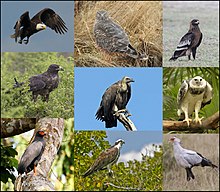
Back Accipitriformes Afrikaans بازيات الشكل Arabic جوارح ARZ Accipitriformes AST Kiizdunol (Accipitriformes) AVK Qırğıkimilər Azerbaijani Ястребоподобни Bulgarian Accipitriformes Breton Accipitriformes Catalan Mandaragit CEB
| Accipitriformes | |
|---|---|

| |
| Clockwise from top left: Bald eagle (Haliaeetus leucocephalus), cinereous harrier (Circus cinereus), greater spotted eagle (Clanga clanga), harpy eagle (Harpia harpyja), secretarybird (Sagittarius serpentarius), osprey (Pandion haliaetus), slate-colored hawk (Buteogallus schistaceus), Galapagos hawk (Buteo galapagoensis), white-backed vulture (Gyps africanus) (center) | |
| Scientific classification | |
| Domain: | Eukaryota |
| Kingdom: | Animalia |
| Phylum: | Chordata |
| Class: | Aves |
| Clade: | Accipitrimorphae |
| Order: | Accipitriformes Vieillot, 1816 |
| Families | |

| |
| Diversity map of Accipitriformes (258 species). The colour gradient (from light to dark) indicates species richness.[2] | |
The Accipitriformes (/ækˈsɪpɪtrɪfɔːrmiːz/; from Latin accipiter/accipitri- "hawk", and Neo-Latin -formes "having the form of") are an order of birds that includes most of the diurnal birds of prey, including hawks, eagles, vultures, and kites, but not falcons.
For a long time, the majority view was to include them with the falcons in the Falconiformes, but many authorities now recognize a separate from Accipitriformes.[3][4][5][6] A DNA study published in 2008 indicated that falcons are not closely related to the Accipitriformes, being instead more closely related to parrots and passerines.[7] Since then, the split and the placement of the falcons next to the parrots in taxonomic order has been adopted by the American Ornithological Society's South American Classification Committee (SACC),[8][9][10] its North American Classification Committee (NACC),[11][12] and the International Ornithological Congress (IOC).[13][14] The British Ornithologists' Union already recognized the Accipitriformes,[15] and has adopted the move of Falconiformes.[16] The DNA-based proposal and the NACC and IOC classifications include the New World vultures in the Accipitriformes,[7][11] while the SACC classifies the New World vultures as a separate order, the Cathartiformes.
- ^ Mayr G, Smith T. A diverse bird assemblage from the Ypresian of Belgium furthers knowledge of early Eocene avifaunas of the North Sea Basin. N Jb Geol Paläontol, Aယကြတ်တူရွေး bh. 2019;291:253–281. doi: 10.1127/njgpa/2019/0801.
- ^ Nagy, Jenő (2020). "Biologia Futura: rapid diversification and behavioural adaptation of birds in response to Oligocene–Miocene climatic conditions" (PDF). Biologia Futura. 71 (1–2): 109–121. Bibcode:2020BioFu..71..109N. doi:10.1007/s42977-020-00013-9. PMID 34554530.
- ^ Voous 1973.
- ^ Cramp 1980, pp. 3, 277.
- ^ Ferguson-Lees & Christie 2001, p. 69.
- ^ Christidis & Boles 2008, pp. 50–51.
- ^ a b Hackett et al. 2008.
- ^ Remsen et al.
- ^ Remsen 2008.
- ^ Nores, Barker & Remsen 2011.
- ^ a b Chesser et al. 2010.
- ^ Chesser et al. 2012.
- ^ Gill & Donsker.
- ^ Gill & Donsker 2014.
- ^ Dudley et al. 2006.
- ^ Sangster et al. 2013.
© MMXXIII Rich X Search. We shall prevail. All rights reserved. Rich X Search